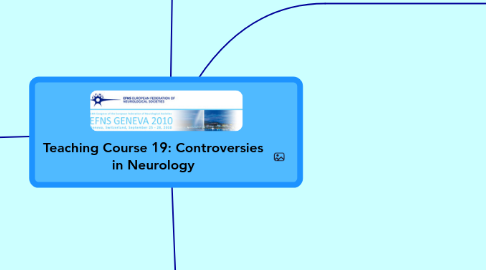
1. Navigation
1.1. EFNS Conference overview
2. Mild Cognitive Impairment
2.1. To Treat
2.1.1. S. Knecht, Germany
2.1.1.1. MCI
2.1.1.1.1. Are you in the process of developing dementia?
2.1.1.1.2. Treat
2.2. Not to Treat
2.2.1. J.-M. Annoni, Switzerland
2.2.1.1. Not enough treatment evidence for standard treatment of MCI
2.2.1.2. Why not?
2.2.1.2.1. MCI is not a valid syndrome
2.2.1.2.2. Specific therapies usually are unreliable
2.2.1.2.3. Therapies have side effects
2.2.1.2.4. There are other approaches
2.2.1.3. Conclusion
2.2.1.3.1. MCI is a mixture of many syndromes
2.2.1.3.2. Specific trials: do not protect against conversion
2.2.1.3.3. Therapies have side effects
2.2.1.3.4. Interventions: Preventive and lifestyle approaches
3. Deep Brain stimulation in PD
3.1. Shall we do it early?
3.1.1. G. Deuschl.
3.1.1.1. When patients cannot walk anymore
3.1.1.2. Speech
3.1.1.3. Studies
3.1.1.3.1. Deep brain stimulation plus best medical therapy vs best medical therapy alone for advanced PD (studies)
3.1.1.3.2. Pallidal vs subthalamic Deep Brain for PD (studies)
3.1.1.3.3. A RT of Deep-Brain Stimulation for PD (studies)
3.1.1.4. Risks
3.1.1.4.1. Picture
3.1.1.4.2. Hardware related long term effects
3.1.1.5. Effects
3.1.1.5.1. Speech improved in most studies
3.1.1.5.2. Gait
3.1.1.5.3. Risk due to stimulation
3.1.1.5.4. Overall efficacy
3.2. Shall we do it late?
3.2.1. Mrs. M. Vidailhet, France
3.2.1.1. The good things
3.2.1.2. Despite the overall excellent outcome of neurosurgery in patients, ther is often a contrast between the improvement in motor disability and the difficulties of patients to reintegrate in normal life
3.2.1.2.1. patients have high expectations
3.2.1.2.2. Does STN meet expectancies
3.2.1.2.3. problems reintegrating in normal life
3.2.1.3. Neurosurgery in PD - A distressed mind in a repaired body?
3.2.1.3.1. Schupbach M et al Neurology 2006
3.2.1.3.2. Examples
3.2.1.4. Is the patient early in the evolution of the disease, will he/she be ready to endure some of the adverse events of STN stimulation?
3.2.1.4.1. eyelid apraxia
3.2.1.4.2. Weight gain
3.2.1.4.3. Apathy
3.2.1.4.4. Behavioral disorders
3.2.1.5. Conclusion?
3.2.1.5.1. The right timing is very important
3.2.1.5.2. ideal candiate
4. Stroke
4.1. N.G. Wahlgren
4.1.1. Mismatch concept MR / DWI - Pro
4.1.1.1. 2 million brain cells die for every minute
4.1.1.2. Dilemma: treat or not to treat based on mismatch concept
4.1.1.3. <4 hours
4.1.1.3.1. 4 hour time window
4.1.1.4. >4 hours
4.1.1.4.1. some patients may benefit
4.1.1.4.2. How to find the right patients
4.1.1.5. imaging
4.1.1.5.1. MR-Angio
4.1.1.5.2. Cerebral blood flow
4.1.1.5.3. MTT
4.1.1.5.4. Conventional
4.1.1.5.5. DWI
4.1.1.6. Does mismatch represent the penumbra?
4.1.1.6.1. Kidwell et al
4.1.1.7. Not successfull yet
4.1.1.7.1. DIAS 1 & 2: desmoteplase in acute ischemic stroke
4.1.1.7.2. DEDAS: dose excalation study of desmoteplase in Acute ischemic Stroke
4.1.1.7.3. EPITHET pilot / EPITHET trial
4.1.1.7.4. to come
4.1.1.8. Conclusion
4.1.1.8.1. the mismatch concept is RIGHT
4.1.1.8.2. There are methodological limitations that need to be solved
4.2. J. Sobesky
4.2.1. Mismatch concept MR / DWI - contra
4.2.1.1. Some pictures follow
4.2.1.1.1. Case Vignette
4.2.1.1.2. Vignette
4.2.1.1.3. pictures
4.2.1.2. How to delineate core and hypoperfusion?
4.2.1.2.1. DWI / false positive DWI
4.2.1.2.2. Is DWI ischaemic core?
4.2.1.2.3. CBF CBV MTT TTP
4.2.1.2.4. PWI - algorhytms
4.2.1.2.5. MRI perfusion maps
4.2.1.2.6. Does mismatch match penumbra?
4.2.1.2.7. Mismatch based on delayed trombolysis
4.2.1.3. this presentation is not fully covered
4.2.2. The debate
